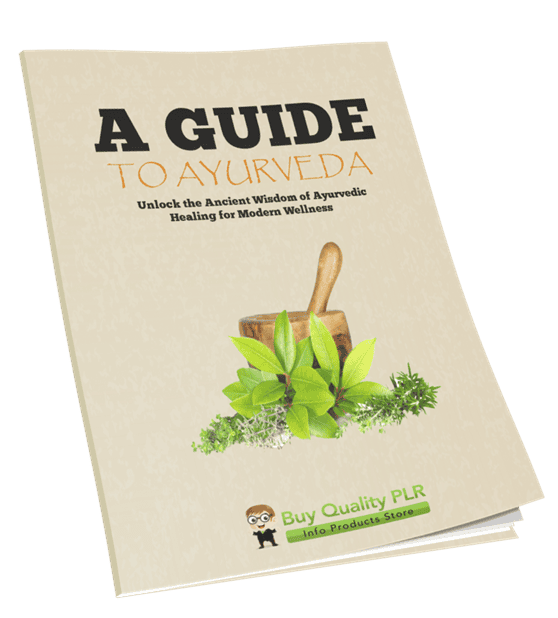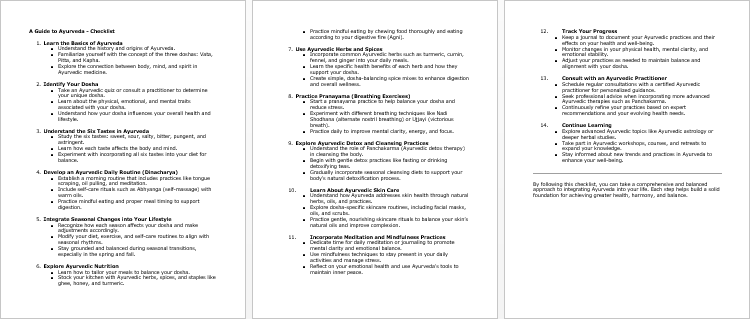
A Guide to Ayurveda PLR Course 26k words
in Healing Ebook MRR , Healing PLR , MRR eBooks , PLR Checklists , PLR eBooks , PLR eCourses , PLR List Building Reports , Premium PLR , Premium PLR eBooks , Premium PLR Reports , Private Label Rights Products , Wellness PLR , Wellness PLR eBooksChoose Your Desired Option(s)
has been added to your cart!
have been added to your cart!
#ayurvedaplr #holistichealing #ayurvedaguide #wellnessplr #naturalhealth #mindbodybalance #alternativemedicine #ayurvediclifestyle #plrcourse #selfhealing
A Guide to Ayurveda PLR Course – Unlock the Ancient Wisdom of Ayurvedic Healing for Modern Wellness
Transform Your Life with Time-Tested Ayurvedic Practices – Learn, Apply, and Share with Our Comprehensive PLR Course!
Are you ready to embrace the ancient healing practices of Ayurveda and integrate them into your modern life? A Guide to Ayurveda PLR Course is a complete, done-for-you solution that provides you with all the knowledge and resources to share the transformative power of Ayurveda.
For just $14.99, you get instant access to a PLR Course containing 23,538 words of expertly crafted content. This course is perfect for anyone looking to learn about Ayurvedic principles and lifestyle practices, or for those wishing to share this wisdom with others through coaching, courses, or membership sites.
Presenting…
A Guide to Ayurveda PLR Course 26k words
What’s Included in “A Guide to Ayurveda” PLR Course?
This PLR Checklists Package is designed to help you understand Ayurveda’s core concepts and easily incorporate them into daily life. Here’s what’s included:
Module 1: Introduction to Ayurveda – Ancient Wisdom for Modern Living
Objective: Understand the roots of Ayurveda and its relevance today.
- Step 1: Understanding the Origins of Ayurveda
Learn about Ayurveda’s history and how it has remained relevant for over 5,000 years. - Step 2: The Philosophy of Ayurveda
Discover the core principles that guide Ayurvedic healing, including balance and harmony. - Step 3: The Tridosha System
Explore the three doshas—Vata, Pitta, and Kapha—and their influence on your health. - Step 4: Your Ayurvedic Constitution
Take a self-assessment quiz to understand your unique dosha balance and learn how to tailor your health practices.
Module 2: The Ayurvedic Lifestyle – Living in Harmony
Objective: Learn how to incorporate Ayurveda into your daily life for balance and vitality.
- Step 1: Dinacharya (Daily Routines)
Adopt Ayurvedic routines, including morning and evening rituals, to ground and balance your energy. - Step 2: The Role of Seasonal Rhythms
Understand how to adjust your lifestyle practices according to the changing seasons. - Step 3: Ayurvedic Sleep Practices
Discover sleep practices that promote deep, restorative rest. - Step 4: Incorporating Mindful Movement
Learn the importance of yoga, pranayama, and walking in Ayurveda for physical and mental health.
Module 3: Ayurvedic Nutrition – Eating for Your Dosha
Objective: Discover how to nourish your body based on your dosha.
- Step 1: Introduction to Ayurvedic Nutrition
Understand Ayurveda’s approach to food as medicine, and learn about the six essential tastes. - Step 2: Identifying Foods for Your Dosha
Learn which foods help balance or aggravate your dosha, and how to create meals for optimal health. - Step 3: Ayurvedic Meal Practices
Embrace mindful eating practices, including portion sizes, meal timing, and the importance of fresh, seasonal food. - Step 4: Ayurvedic Herbs and Spices
Learn about the healing properties of spices like turmeric, cumin, and fennel, and how to incorporate them into your meals.
Module 4: Healing Practices – Ayurveda for Wellness
Objective: Learn natural remedies and self-care practices for physical, mental, and emotional well-being.
- Step 1: Introduction to Self-Care Practices
Explore Ayurvedic self-care routines like Abhyanga (self-massage) and how they support relaxation and detoxification. - Step 2: Ayurvedic Remedies for Common Ailments
Discover herbal remedies for digestion, stress relief, and energy boosts. - Step 3: Detox and Cleansing Practices
Learn about Ayurvedic detox methods like fasting and cleansing diets, along with advanced techniques such as Panchakarma. - Step 4: Emotional and Mental Health in Ayurveda
Practice Ayurvedic tools for emotional balance, including meditation and journaling for mental clarity.
Module 5: Ayurveda in Everyday Life – Personalized Practices
Objective: Create a personalized Ayurvedic lifestyle plan that suits your unique needs.
- Step 1: Creating a Personalized Daily Routine
Design your ideal Ayurvedic routine tailored to your dosha and wellness goals. - Step 2: Setting Up Your Ayurvedic Kitchen
Learn how to stock your kitchen with Ayurvedic staples and prepare dosha-balancing meals. - Step 3: Building Consistency in Your Practice
Incorporate Ayurvedic practices into your daily life with simple tips and habit-tracking tools. - Step 4: Reflection and Next Steps
Reflect on your Ayurvedic journey and explore advanced topics for continued learning.
Bonus Materials Included
- A Guide to Ayurveda Checklist (663 Words)
A concise checklist summarizing the key Ayurvedic practices to help you stay on track. - A Guide to Ayurveda FAQs (1,077 Words)
A comprehensive FAQ guide that answers common questions and clarifies Ayurvedic practices. - A Guide to Ayurveda Sales Page (925 Words)
A professionally written sales page designed to help you market and sell the Ayurvedic PLR Course quickly and effectively.
How to Use and Profit from “A Guide to Ayurveda” PLR Course
Here’s how you can use this PLR Checklists Package to build a sustainable business:
- Direct Sales:
Sell the PLR Course as-is for $14.99. This course is ideal for anyone looking to embrace Ayurveda and improve their health. - Mini-Courses or Reports:
Break the course into smaller modules or reports and sell them individually for $10-$20 each. Focus on specific topics like Ayurvedic nutrition or self-care. - Bundle with Other Wellness Content:
Combine the course with other health and wellness content for a larger product offering. Sell the package for $47-$97 for a complete wellness transformation. - Membership Site:
Create a membership site where people can subscribe for ongoing Ayurveda content and coaching. Charge a monthly fee for access. - Eclass or Coaching Program:
Convert the course into a multi-week eclass or coaching program and charge $297-$497 for access. Guide clients through their Ayurvedic journey. - Physical Products:
Use the course to create physical products like Ayurvedic recipe books or planners. Sell them at a premium price in stores or online. - Lead Magnets and Free Content:
Use portions of the course or the checklist as free content or lead magnets to grow your email list and attract more customers. - Affiliate Program:
Set up an affiliate program and offer up to 75% commission to affiliates who help promote and sell the course.
License Terms:
- What You Can Do:
You can edit, rebrand, and sell the content. Break the course into smaller parts, bundle it with other content, or create derivative products like courses, workshops, or physical products. - What You Can’t Do:
You cannot pass on PLR rights or resale rights to your customers. The content must be sold and not given away for free. You cannot offer 100% affiliate commissions (maximum 75% commission).
Get Instant Access to “A Guide to Ayurveda” PLR Course for Just $14.99!
Start living a balanced and harmonious life today with Ayurveda! For only $14.99, you’ll get A Guide to Ayurveda PLR Course, complete with everything you need to understand, apply, and share Ayurvedic wisdom.
Embrace the ancient healing practices of Ayurveda and transform your health!
has been added to your cart!
have been added to your cart!
Here A Sample of A Guide to Ayurveda PLR Course
Dive into the ancient wisdom of Ayurveda and learn how to harmonize your body, mind, and spirit. This course will guide you through foundational concepts, practical tips, and personalized tools to incorporate Ayurveda into your daily life.
Module 1: Introduction to Ayurveda – Ancient Wisdom for Modern Living
Objective: Understand the roots of Ayurveda and its relevance today.
Step 1: Understanding the Origins of Ayurveda
Introduction to Ayurveda’s Historical Roots
Ayurveda, which translates to “The Science of Life,” is one of the oldest systems of natural healing in the world. It originated in India over 5,000 years ago and is deeply rooted in the ancient texts known as the Vedas. These sacred texts, specifically the Rigveda, Yajurveda, Samaveda, and Atharvaveda, serve as the foundation for Ayurvedic wisdom.
The knowledge of Ayurveda was traditionally passed down orally through generations of sages (rishis) before being compiled into written form in classical texts like the Charaka Samhita, Sushruta Samhita, and Ashtanga Hridayam. These texts outline the principles of health, wellness, and treatment strategies, making Ayurveda a holistic system addressing the mind, body, and spirit.
Connection to Ancient Indian Culture
Ayurveda is not just a medical practice but a way of life that influenced ancient Indian society in profound ways:
- Daily Life: Ayurvedic principles guided daily routines (dinacharya), seasonal practices (ritucharya), and dietary habits. These practices were deeply integrated into the cultural fabric.
- Spirituality and Healing: Ayurveda’s foundation is closely tied to Indian spirituality, emphasizing balance, harmony, and the interconnectedness of all living beings.
- Role of Yoga: Ayurveda and yoga were developed in tandem, with yoga serving as a complementary practice for mental and physical well-being. Together, they form a comprehensive system of health and longevity.
Understanding this cultural connection helps you see Ayurveda as more than a set of treatments—it’s a philosophy of life, woven into the traditions, rituals, and practices of ancient India.
The Timeless Relevance of Ayurveda
While Ayurveda is an ancient science, its principles are surprisingly relevant today, offering solutions to modern health challenges. Let’s explore why:
- Personalized Healthcare
Unlike a one-size-fits-all approach, Ayurveda recognizes the uniqueness of every individual through the concept of Prakriti (one’s natural constitution) and offers customized solutions for diet, lifestyle, and treatments. This personalized approach is increasingly valued in modern healthcare systems. - Holistic Approach
Ayurveda emphasizes treating the root cause of ailments rather than just the symptoms. This aligns with modern integrative medicine, which seeks to combine the best of traditional and contemporary healthcare practices. - Natural and Sustainable Practices
Ayurveda promotes the use of natural herbs, oils, and therapies, which are environmentally friendly and sustainable. In an era of rising concerns about synthetic chemicals and their impact on health, Ayurveda offers an eco-conscious alternative. - Stress and Mental Health
With the global rise in stress-related disorders, Ayurveda’s focus on mental balance, meditation, and stress-relief techniques (such as Shirodhara and herbal teas) resonates with individuals seeking peace in a fast-paced world. - Preventive Healthcare
Ayurveda’s preventive focus—through balanced nutrition, exercise, and lifestyle—aligns with modern trends in proactive wellness. Its emphasis on immunity-building has become particularly relevant post-pandemic.
Why This Knowledge Matters for You as an International Course Creator
Understanding Ayurveda’s history and cultural roots is essential to teach it authentically and effectively to a global audience. Here’s why:
- Cultural Sensitivity: Appreciating Ayurveda’s connection to Indian culture helps you convey its essence while respecting its origins. This is particularly important to avoid cultural appropriation and ensure integrity in your course.
- Contextual Relevance: By exploring Ayurveda’s timeless principles, you can draw parallels to modern lifestyles, making the course relatable for an international audience.
- Building Credibility: A deep understanding of Ayurveda’s historical and cultural foundation establishes your authority as a course creator and ensures your audience trusts your expertise.
Actionable Insights for Course Implementation
Here are steps to incorporate this topic into your training program:
- Start with a Story: Share an engaging story or anecdote about Ayurveda’s origin. For example, discuss how sages discovered healing practices by observing nature, like the behavior of animals or the properties of plants.
- Illustrate with Visuals: Use maps, historical timelines, and visuals of ancient Ayurvedic manuscripts to make the content more engaging.
- Draw Modern Parallels: Highlight how Ayurveda’s ancient principles can address current global issues such as stress, chronic illnesses, and environmental sustainability.
- Encourage Reflection: Ask learners to reflect on their current healthcare practices and identify areas where they could apply Ayurveda’s personalized and holistic approach.
Conclusion
By understanding the origins of Ayurveda, learners gain a foundational appreciation for its depth and richness. This step sets the stage for exploring how this ancient science can transform modern lives, emphasizing Ayurveda’s universal appeal and timeless wisdom.
Step 2: The Philosophy of Ayurveda
Introduction to Ayurveda’s Core Philosophy
The philosophy of Ayurveda revolves around the concept of balance—within the body, the mind, and the environment. It views health not merely as the absence of disease but as a state of holistic well-being. To fully grasp Ayurveda’s philosophy, it is important to understand the principles that govern life according to this ancient science.
Ayurveda is built on the idea that humans are microcosms of the universe, meaning that the same elements and forces that exist in nature also exist within us. When these forces are in harmony, we experience health. When they are out of balance, illness occurs.
Step-by-Step Course Instructions
Step 1: Understanding the Three Pillars of Health (Trayo Upastambha)
Ayurveda identifies three fundamental pillars that sustain life and health:
- Food (Ahara)
- The type of food you eat, how you prepare it, and how you consume it greatly impact your health. Ayurveda emphasizes eating fresh, natural, and seasonal foods tailored to your constitution (Prakriti) to maintain balance.
- Practical Insight for Course Creators: Explain how different dietary habits (like overeating, irregular meals, or processed foods) lead to imbalances, and provide examples of healthy alternatives.
- Sleep (Nidra)
- Restorative sleep is vital for the body to repair itself. Ayurveda views sleep as essential for mental clarity and physical energy. Poor sleep patterns disturb the natural balance and lead to physical and mental stress.
- Practical Insight: Include tips on promoting better sleep, such as maintaining a consistent sleep schedule, avoiding stimulants, and creating a calming bedtime routine.
- Lifestyle Practices (Brahmacharya)
- This refers to balanced living, which includes mindful daily routines, balanced physical activity, and self-care. Overindulgence, stress, or neglect of these aspects disrupts balance.
- Practical Insight: Encourage learners to create a structured daily schedule, incorporating practices like meditation, light exercise, and leisure time.
Step 2: Exploring the Concept of Balance (Sama)
At its core, Ayurveda aims to achieve Sama—perfect balance between:
- Doshas (Vata, Pitta, Kapha): These are the bio-energies that govern the body. Each person has a unique balance of these doshas, and maintaining this balance is key to good health.
- Vata: Governs movement and creativity.
- Pitta: Regulates metabolism, digestion, and intellect.
- Kapha: Ensures stability, lubrication, and immunity.
- Practical Insight: Teach learners how imbalances in these doshas manifest as physical and emotional issues, such as dryness (Vata imbalance), acidity (Pitta imbalance), or sluggishness (Kapha imbalance).
- The Three Gunas (Mental Qualities):
- Sattva: Represents clarity, harmony, and positivity.
- Rajas: Stands for activity, passion, and restlessness.
- Tamas: Represents inertia, dullness, and ignorance.
- Practical Insight: Guide learners to cultivate more Sattva through practices like meditation, uplifting environments, and consuming fresh, plant-based foods.
Step 3: The Interconnection of Mind, Body, and Environment
Ayurveda recognizes that health is influenced not just by what’s inside you but also by the world around you. This connection can be understood through three principles:
- Your Inner World Reflects Your Outer World:
- Ayurveda emphasizes that harmony in your environment is essential for inner peace. A cluttered, chaotic space leads to a disturbed mind, while a clean, peaceful space fosters tranquility.
- Practical Insight: Encourage learners to create a calming environment, including natural lighting, soothing colors, and plants that purify the air.
- Seasonal and Environmental Rhythms (Ritucharya):
- The body is deeply connected to nature’s cycles. Ayurveda recommends aligning with seasonal changes to stay healthy, such as eating warm foods in winter and cooling foods in summer.
- Practical Insight: Provide learners with a seasonal lifestyle chart to help them adapt their habits and diet to the changing environment.
- The Mind-Body Link:
- Mental health directly impacts physical health and vice versa. Stress, anxiety, or unresolved emotions can create imbalances in the doshas, while physical issues can lead to mental disturbances.
- Practical Insight: Teach simple stress-management practices like deep breathing (Pranayama) and meditation to restore balance.
Step 4: Aligning with Nature’s Elements
According to Ayurveda, the five elements (Panchamahabhutas)—Earth, Water, Fire, Air, and Ether—are the building blocks of the universe and exist within every individual. Understanding these elements helps us align with nature and maintain balance.
- Earth: Represents stability and strength.
- Practices like grounding (walking barefoot) or eating nutrient-dense foods enhance Earth’s qualities.
- Water: Symbolizes fluidity and connection.
- Staying hydrated and practicing flow-based movements like yoga support this element.
- Fire: Represents transformation and energy.
- Activities like cooking, goal-setting, or practicing controlled breathing (to cool or ignite fire) balance this element.
- Air: Governs movement and inspiration.
- Creative activities and practices like journaling support this element.
- Ether: Represents space and stillness.
- Silence, meditation, and spending time in open spaces balance Ether.
Practical Insight: Guide learners in identifying which elements they need to nurture based on their current mental and physical state.
Why This Philosophy Matters for Your Audience
For international learners, Ayurveda’s philosophy offers a refreshing perspective on health as a state of harmony rather than just freedom from disease. Emphasizing balance makes it universally applicable to people across cultures, lifestyles, and health conditions.
Conclusion
By exploring the philosophy of Ayurveda, learners understand that health is not just about the absence of illness but the presence of balance and harmony. This knowledge lays a strong foundation for the practical steps they’ll take in the course. Encourage learners to reflect on areas in their life—diet, lifestyle, environment—that may currently feel “out of balance” and how Ayurveda’s timeless wisdom can guide them toward harmony.
Step 3: The Tridosha System
Introduction to the Tridosha System
The Tridosha system is one of the cornerstones of Ayurveda. It explains how three biological energies—Vata, Pitta, and Kapha—govern all physical, mental, and emotional processes within the body. Each individual has a unique balance of these doshas, which determines their constitution or Prakriti. Understanding the Tridosha system allows us to identify imbalances that cause disease and take steps toward restoring harmony.
Step-by-Step Course Instructions
Step 1: Understanding the Three Doshas
The doshas are derived from the five elements (Earth, Water, Fire, Air, and Ether) and influence all bodily functions. Here’s a breakdown of each dosha:
- Vata Dosha (Air + Ether)
- Role: Governs movement in the body, including blood flow, nerve impulses, and breathing.
- Characteristics: Light, dry, cold, and mobile. Individuals with dominant Vata energy are often creative, energetic, and quick thinkers.
- Signs of Balance: Creativity, adaptability, and enthusiasm.
- Signs of Imbalance: Anxiety, insomnia, digestive issues (like bloating), and dry skin.
- Pitta Dosha (Fire + Water)
- Role: Governs transformation in the body, including digestion, metabolism, and energy production.
- Characteristics: Hot, sharp, oily, and intense. People with dominant Pitta energy are often ambitious, driven, and goal-oriented.
- Signs of Balance: Strong digestion, clarity of thought, and good leadership skills.
- Signs of Imbalance: Anger, irritability, acidity, and inflammation.
- Kapha Dosha (Earth + Water)
- Role: Governs structure and stability in the body, including immunity, lubrication of joints, and physical growth.
- Characteristics: Heavy, cool, slow, and steady. Kapha-dominant individuals are calm, nurturing, and loyal.
- Signs of Balance: Strength, endurance, and emotional stability.
- Signs of Imbalance: Lethargy, weight gain, depression, and mucus buildup.
Actionable Insights for Learners
- Teach your learners to recognize their unique dosha composition. Use quizzes or self-assessments based on physical traits, personality tendencies, and preferences.
- Example Question: “Do you frequently feel cold and experience dry skin? If yes, you may have a Vata imbalance.”
Step 2: How Doshas Influence Physical, Mental, and Emotional Health
The doshas play a critical role in maintaining overall health. When they are in balance, they work together to sustain harmony. When imbalanced, they contribute to disease. Let’s explore their influence:
Physical Health
- Vata: Impacts movement, so imbalances can cause joint pain, constipation, and irregular menstrual cycles.
- Pitta: Manages digestion and metabolism, so an imbalance may result in ulcers, heartburn, or excessive sweating.
- Kapha: Governs strength and immunity, so imbalance leads to weight gain, respiratory issues, and sluggishness.
Mental Health
- Vata: Imbalances cause fear, anxiety, and restlessness.
- Pitta: Imbalances result in anger, frustration, and overcritical thinking.
- Kapha: Imbalances cause sadness, attachment, and lack of motivation.
Emotional Health
- Balanced doshas foster emotional well-being:
- Vata encourages creativity.
- Pitta fosters passion and determination.
- Kapha cultivates compassion and calmness.
Practical Insight for Course Creators
- Provide real-life examples of how doshas manifest in daily life. For instance, if someone feels irritable and overheated during summer, explain how it may be a Pitta imbalance.
- Encourage learners to track how they feel physically, mentally, and emotionally under different circumstances.
Step 3: Identifying Dosha Imbalances
Recognizing dosha imbalances is key to restoring harmony. Teach learners how to spot these signs:
- Symptoms of Vata Imbalance:
- Restlessness, fatigue, poor sleep, and digestive issues like bloating or gas.
- Dry skin, brittle nails, and irregular eating patterns.
- Symptoms of Pitta Imbalance:
- Irritability, short temper, and a tendency to overwork.
- Skin rashes, acidity, or an intense feeling of heat in the body.
- Symptoms of Kapha Imbalance:
- Lack of motivation, weight gain, and difficulty waking up.
- Mucus buildup, sinus congestion, and sluggish digestion.
Actionable Tips for Learners
- Teach learners to observe patterns in their physical and emotional health. For instance, if they feel more tired and heavy during winter, explain how this could be a Kapha imbalance.
- Provide a worksheet or guide for learners to record and track their symptoms over a week.
Step 4: Balancing the Doshas Through Lifestyle Changes
Ayurveda emphasizes that lifestyle adjustments can help restore balance to the doshas. Here’s how:
For Vata Imbalances:
- Diet: Focus on warm, grounding foods like soups, stews, and healthy fats. Avoid raw, cold foods.
- Lifestyle: Create a structured daily routine, prioritize rest, and practice calming activities like yoga or meditation.
- Environment: Stay warm and avoid overly stimulating environments.
For Pitta Imbalances:
- Diet: Eat cooling, hydrating foods like cucumbers, melons, and leafy greens. Avoid spicy or fried foods.
- Lifestyle: Practice relaxation techniques like mindfulness or cooling Pranayama (breathing exercises).
- Environment: Avoid excessive heat and focus on calming activities like walks in nature.
For Kapha Imbalances:
- Diet: Emphasize light, spicy foods like ginger tea, lentils, and steamed vegetables. Avoid heavy, oily foods.
- Lifestyle: Incorporate regular exercise, energizing activities, and wake up early to stay active.
- Environment: Spend time in bright, lively spaces and avoid overindulging in sedentary activities.
Practical Insights for Course Creators
- Provide learners with actionable strategies to balance their doshas through diet, exercise, and mindfulness.
- Share easy recipes and daily routines tailored to each dosha.
Conclusion
By understanding the Tridosha system, learners gain insight into how their body, mind, and emotions are interconnected. They also learn how to identify imbalances and make informed lifestyle adjustments to restore harmony. This knowledge not only empowers them to take charge of their health but also helps them appreciate the personalized approach of Ayurveda.
As a course creator, ensure that this step is highly interactive. Use real-life examples, self-assessments, and practical solutions to make the learning process engaging and relatable for an international audience.
We’re also giving these extra bonuses
A Guide to Ayurveda – Checklist

A Guide to Ayurveda – FAQs

A Guide to Ayurveda – Salespage Content

Package Details:
Word Count: 23 538 Words
Number of Pages: 100
A Guide to Ayurveda – Bonus Content
Checklist
Word Count: 663 words
FAQs
Word Count: 1077 words
Salespage Content
Word Count: 925 words
Total Word Count: 26 203 Words
Your PLR License Terms
PERMISSIONS: What Can You Do With These Materials?
Sell the content basically as it is (with some minor tweaks to make it “yours”).
If you are going to claim copyright to anything created with this content, then you must substantially change at 75% of the content to distinguish yourself from other licensees.
Break up the content into small portions to sell as individual reports for $10-$20 each.
Bundle the content with other existing content to create larger products for $47-$97 each.
Setup your own membership site with the content and generate monthly residual payments!
Take the content and convert it into a multiple-week “eclass” that you charge $297-$497 to access!
Use the content to create a “physical” product that you sell for premium prices!
Convert it to audios, videos, membership site content and more.
Excerpt and / or edit portions of the content to give away for free as blog posts, reports, etc. to use as lead magnets, incentives and more!
Create your own original product from it, set it up at a site and “flip” the site for megabucks!
RESTRICTIONS: What Can’t You Do With These Materials?
To protect the value of these products, you may not pass on the rights to your customers. This means that your customers may not have PLR rights or reprint / resell rights passed on to them.
You may not pass on any kind of licensing (PLR, reprint / resell, etc.) to ANY offer created from ANY PORTION OF this content that would allow additional people to sell or give away any portion of the content contained in this package.
You may not offer 100% commission to affiliates selling your version / copy of this product. The maximum affiliate commission you may pay out for offers created that include parts of this content is 75%.
You are not permitted to give the complete materials away in their current state for free – they must be sold. They must be excerpted and / or edited to be given away, unless otherwise noted. Example: You ARE permitted to excerpt portions of content for blog posts, lead magnets, etc.
You may not add this content to any part of an existing customer order that would not require them to make an additional purchase. (IE You cannot add it to a package, membership site, etc. that customers have ALREADY paid for.)
Deprecated: Function post_permalink is deprecated since version 4.4.0! Use get_permalink() instead. in /home/buyqualityplr/public_html/wp-includes/functions.php on line 6121
Share Now!












